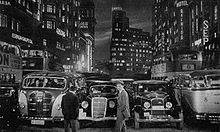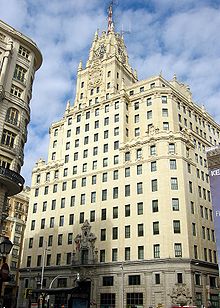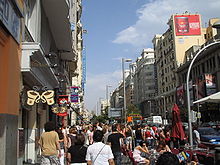
Gran Vía
Encyclopedia






_25.jpg)
Madrid
Madrid is the capital and largest city of Spain. The population of the city is roughly 3.3 million and the entire population of the Madrid metropolitan area is calculated to be 6.271 million. It is the third largest city in the European Union, after London and Berlin, and its metropolitan...
. It leads from Calle de Alcalá
Calle de Alcalá
Calle de Alcalá is the longest street in Madrid. It starts at the Puerta del Sol and goes on for 10.5 km, to the northeastern outskirts of the city....
, close to Plaza de Cibeles
Plaza de Cibeles
The Plaza de Cibeles is a square with a neo-classical complex of marble sculptures with fountains that has become an iconic symbol for the city of Madrid.-Cibeles Fountain:...
, to Plaza de España
Plaza de España (Madrid)
Plaza de España is a large square, and popular tourist destination, located in central Madrid, Spain, at the western end of the Gran Vía. It features a monument to Miguel de Cervantes Saavedra, and is bordered by two of Madrid's most prominent skyscrapers...
.
The lively street is one of the city's most important shopping areas, with a large number of hotels and large movie theaters; it is also noted for the grand architecture prevalent among many of its buildings. Now, most of the theaters are being replaced by shopping malls.
It is considered a showcase of early 20th century architecture, with patterns ranging from Vienna Secession
Vienna Secession
The Vienna Secession was formed in 1897 by a group of Austrian artists who had resigned from the Association of Austrian Artists, housed in the Vienna Künstlerhaus. This movement included painters, sculptors, and architects...
style, Plateresque
Plateresque
Plateresque, meaning "in the manner of a silversmith" , was an artistic movement, especially architectural, traditionally held to be exclusive to Spain and its territories, which appeared between the late Gothic and early Renaissance in the late 15th century, and spread over the next two centuries...
, Neo-Mudéjar
Neo-Mudéjar
The Neo-Mudéjar is an architectural movement which originated in Spain and emerged as a revival of the Mudéjar architecture. It appeared in the late 19th century in Madrid, and soon spread to other regions of the country. Such architects as Emilio Rodríguez Ayuso perceived the Mudéjar art as...
, Art Deco
Art Deco
Art deco , or deco, is an eclectic artistic and design style that began in Paris in the 1920s and flourished internationally throughout the 1930s, into the World War II era. The style influenced all areas of design, including architecture and interior design, industrial design, fashion and...
and others.
Conception
In the mid 19th century, Madrid's urban planners decided that a new thoroughfare had to be created, connecting the Calle de Alcalá with the Plaza de EspañaPlaza de España (Madrid)
Plaza de España is a large square, and popular tourist destination, located in central Madrid, Spain, at the western end of the Gran Vía. It features a monument to Miguel de Cervantes Saavedra, and is bordered by two of Madrid's most prominent skyscrapers...
. The project required many buildings in the center of the city to be demolished, earning it the name of 'an axe blow on the map'. Decades after the first plans were made, construction still hadn't started and the media ridiculed the project, cynically calling it the 'Gran Vía' or 'Great Road'. Finally in 1904 it was approved and construction started a couple of years later. The last part of the street was completed in 1929.
High buildings
The new road created opportunities for architects, who had the ability to create large buildings in the latest architectural styles. The first eye catching building starting from the Calle de AlcaláCalle de Alcalá
Calle de Alcalá is the longest street in Madrid. It starts at the Puerta del Sol and goes on for 10.5 km, to the northeastern outskirts of the city....
is the most famous of all, the Edificio Metrópolis or Metropolis Building
Metropolis Building
The Metropolis Building or Edificio Metrópolis is an office building in Madrid, Spain, at the corner of the Calle de Alcalá and Gran Vía. Inaugurated in 1911, it was designed by Jules and Raymond Février for the insurance company La Unión y el Fénix...
. The landmark was built between 1907 and 1911 after a design by the architects Jules and Raymond Février. The original statue was replaced in 1975 by a statue of a winged Goddess Victory
Victoria (mythology)
In ancient Roman religion, Victoria was the personified goddess of victory. She is the Roman equivalent of the Greek goddess Nike, and was associated with Bellona. She was adapted from the Sabine agricultural goddess Vacuna and had a temple on the Palatine Hill...
.
A bit further along the Gran Vía, on the left hand side is another landmark, the Edificio Grassy
Edificio Grassy
The Edificio Grassy is a building located in Gran Vía 1, in Madrid, Spain.-Architecture:Situated just off Calle de Alcalá, at the very beginning of Gran Vía, the Edificio Grassy was built between 1916 and 1917. It was constructed on a triangular piece of land, in the same way as the Edificio...
, another corner building with a small tower, built in 1917. Visible from here is the tower of the Telefónica Building
Telefónica Building
The Telefónica Building, in Spanish Edificio Telefónica, is a skyscraper in Madrid, Spain. It is situated in Gran Vía 28.-History:The Telefónica Building was designed by Ignacio de Cárdenas, who conceived it after a previous study of Lewis S. Weeks in Manhattan...
, the first European skyscraper built between 1926 and 1929 for the Spanish telecommunications company
Telefónica
Telefónica, S.A. is a Spanish broadband and telecommunications provider in Europe and Latin America. Operating globally, it is the third largest provider in the world...
. The 88-meter (290 ft) building was the tallest in Madrid and was designed by an American, Louis S. Weeks.
Plaza del Callao
Farther towards the Plaza de España, the Gran Vía crosses a small square, the Plaza del Callao, named after the battle of El Callao. This square is the heart of cinematic Madrid, with about six movie theaters. One of them, the Capitol, is located in a beautiful Art DecoArt Deco
Art deco , or deco, is an eclectic artistic and design style that began in Paris in the 1920s and flourished internationally throughout the 1930s, into the World War II era. The style influenced all areas of design, including architecture and interior design, industrial design, fashion and...
building.
However, changes in building rules have allowed the reform of the theaters into more lucrative shopping centers.
Plaza de España
The last part of the Gran Vía, constructed between 1925 and 1929 leads to the Plaza de EspañaPlaza de España (Madrid)
Plaza de España is a large square, and popular tourist destination, located in central Madrid, Spain, at the western end of the Gran Vía. It features a monument to Miguel de Cervantes Saavedra, and is bordered by two of Madrid's most prominent skyscrapers...
, a large square dominated by two skyscrapers built in the 1950s, the symmetric Edificio España
Edificio España
The Edificio España is one of the tallest buildings in Madrid, Spain. With its 25 storeys and 117 meters of height, it is the eighth-highest building of the Spanish capital, including the skyscrapers of the Cuatro Torres Business Area. It is also one of the better examples of twentieth century...
and the Torre de Madrid
Torre de Madrid
The Torre de Madrid is one of the tallest buildings in Madrid. It measures 142 metres in height, has 36 floors and was constructed between 1954 and 1957...
. Here the Gran Vía becomes the Calle Princesa, leading north to the Arco de la Victoria.
Names of the way
The Gran Vía of Madrid has many historical names, both official and unofficial. Conception divided the Road in three parts. The first one was built between 1910 and 1917 and was called Calle del Conde de Peñalver ("Count of Peñalver Street"). Second part of the project started on 1917 and was ended on 1921. It was named Calle de Pi y Margall ("Francisco Pi y MargallFrancisco Pi y Margall
Francisco Pi y Margall was a liberal Spanish statesman and romanticist writer. He was briefly president of the short-lived First Spanish Republic in 1873.-Early life:...
Street") after a deceased politician. The third part of the road, and the last one, did not start until 1925 and was called Calle Eduardo Dato Iradier ("Eduardo Dato Street") after another politician.
Three months before the Spanish Civil War
Spanish Civil War
The Spanish Civil WarAlso known as The Crusade among Nationalists, the Fourth Carlist War among Carlists, and The Rebellion or Uprising among Republicans. was a major conflict fought in Spain from 17 July 1936 to 1 April 1939...
began, the Second Spanish Republic
Second Spanish Republic
The Second Spanish Republic was the government of Spain between April 14 1931, and its destruction by a military rebellion, led by General Francisco Franco....
changed some street names under leftist influence. The two first parts of the avenue were called Avenida de la C.N.T. ("C.N.T.
Confederación Nacional del Trabajo
The Confederación Nacional del Trabajo is a Spanish confederation of anarcho-syndicalist labor unions affiliated with the International Workers Association . When working with the latter group it is also known as CNT-AIT...
Avenue"). When the Civil War started, the avenue was renamed Avenida de Rusia ("Russia
Russia
Russia or , officially known as both Russia and the Russian Federation , is a country in northern Eurasia. It is a federal semi-presidential republic, comprising 83 federal subjects...
Avenue") due to the support of this country for the Spanish Republic, but soon its name would be changed to Avenida de la Unión Soviética ("Soviet Union
Soviet Union
The Soviet Union , officially the Union of Soviet Socialist Republics , was a constitutionally socialist state that existed in Eurasia between 1922 and 1991....
Avenue"). However, the avenue was popularly nicknamed as Avenida de los obuses ("howitzer
Howitzer
A howitzer is a type of artillery piece characterized by a relatively short barrel and the use of comparatively small propellant charges to propel projectiles at relatively high trajectories, with a steep angle of descent...
avenue") because of the continued bombardments by the Nationalist forces loyal to Francisco Franco
Francisco Franco
Francisco Franco y Bahamonde was a Spanish general, dictator and head of state of Spain from October 1936 , and de facto regent of the nominally restored Kingdom of Spain from 1947 until his death in November, 1975...
. The reason for these attacks in this area was that the "Edificio de Telefónica" (the Spanish phone company) is in this street.
Just after the end of the war when the rebels entered Madrid
Madrid
Madrid is the capital and largest city of Spain. The population of the city is roughly 3.3 million and the entire population of the Madrid metropolitan area is calculated to be 6.271 million. It is the third largest city in the European Union, after London and Berlin, and its metropolitan...
they changed the name of the road and renamed it Avenida de José Antonio ("José Antonio
José Antonio Primo de Rivera
José Antonio Primo de Rivera y Sáenz de Heredia, 1st Duke of Primo de Rivera, 3rd Marquis of Estella , was a Spanish lawyer, nobleman, politician, and founder of the Falange Española...
Avenue") after one of their greatest political figures, founder of the fascist party, Falange
Falange
The Spanish Phalanx of the Assemblies of the National Syndicalist Offensive , known simply as the Falange, is the name assigned to several political movements and parties dating from the 1930s, most particularly the original fascist movement in Spain. The word means phalanx formation in Spanish....
. It wouldn't be until 1981, under Spain
Spain
Spain , officially the Kingdom of Spain languages]] under the European Charter for Regional or Minority Languages. In each of these, Spain's official name is as follows:;;;;;;), is a country and member state of the European Union located in southwestern Europe on the Iberian Peninsula...
democracy when the socialist mayor restored the names of 27 streets and the avenue was simply named Gran Vía ("Great Road").
In media
- La Gran Vía is a zarzuelaZarzuelaZarzuela is a Spanish lyric-dramatic genre that alternates between spoken and sung scenes, the latter incorporating operatic and popular song, as well as dance...
. - In a famous scene of the Álex de la IglesiaÁlex de la IglesiaAlejandro "Álex" de la Iglesia Mendoza is a Spanish film director, screenwriter, film producer and former comic book artist.Most of De La Iglesia's films reached cult status due to their weird sense of humour.- Biography :...
's 1995 sci-fi/horror film The Day of the Beast, Santiago SeguraSantiago SeguraSantiago Segura Silva is a Spanish film actor, screenwriter, producer and director.Santiago was born in the Carabanchel neighbourhood in Madrid. After studying Arts at the Complutense University of Madrid, he decided to pursue a career as a film-maker and in 1989 he directed the short Relatos de...
hangs above Gran Vía from the iconic neon advertisement for Schweppes on Edificio Carrión/Capitol. - Gran ViaGran VíaGran Vía is an ornate and upscale shopping street located in central Madrid. It leads from Calle de Alcalá, close to Plaza de Cibeles, to Plaza de España....
is also the title of the 1995 album by Matt BiancoMatt BiancoMatt Bianco is a UK band that was formed in 1983. They are mainly known for their success in the mid 1980s and their jazz, Latin-flavoured music....
. - The Sun Also RisesThe Sun Also RisesThe Sun Also Rises is a 1926 novel written by American author Ernest Hemingway about a group of American and British expatriates who travel from Paris to the Festival of San Fermín in Pamplona to watch the running of the bulls and the bullfights. An early and enduring modernist novel, it received...
by Ernest HemingwayErnest HemingwayErnest Miller Hemingway was an American author and journalist. His economic and understated style had a strong influence on 20th-century fiction, while his life of adventure and his public image influenced later generations. Hemingway produced most of his work between the mid-1920s and the...
ends with Jake and Brett in a taxi on Gran Via. - At the end of Georges ConchonGeorges ConchonGeorges Conchon was a French writer and screenwriter.-Biography :He grew up in a family of teachers, and after graduating in philosophy, passed the support of the parliamentary and between the Assembly French Union where he was division head from 1952 to 1958.He began writing, while traveling...
's 1959 novel "La Corrida de la victoire" (published in English as "The Hollow Victory") the protagonist - a former soldier of the Spanish RepublicSecond Spanish RepublicThe Second Spanish Republic was the government of Spain between April 14 1931, and its destruction by a military rebellion, led by General Francisco Franco....
, fleeing Spain after FrancoFrancisco FrancoFrancisco Franco y Bahamonde was a Spanish general, dictator and head of state of Spain from October 1936 , and de facto regent of the nominally restored Kingdom of Spain from 1947 until his death in November, 1975...
's victory - takes the quixotic and defiant gesture of openly walking one last time along the Gran Vía in August 1939, at a considerable risk to his life since captured Republicans were at this time often shot out of hand.
External links
- http://www.aviewoncities.com/madrid/granvia.htm (Source)
- Official website of the Gran Vía Centenary – Madrid Council
- Gran Vía guide and history – Madrid Council

